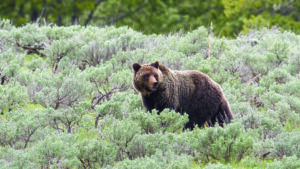Grizzly bears once ranged throughout most of the Western United States, however, their abundance and distribution were greatly diminished by excessive human-caused mortality and loss of habitat and as a result they were listed as a threatened species in the contiguous U.S under the Endangered Species Act. The U.S. Fish and Wildlife Service (USFWS) is now announcing a public scoping period to consider options for restoring grizzly bears to the Bitterroot Ecosystem, a portion of the species’ historical range, in Montana and Idaho. It is one of the six identified grizzly bear recovery zones in the lower 48 states. A recovery zone is an area large enough and of sufficient habitat quality to support a recovered grizzly bear population. The goal of the recovery plan is to reduce threats to the grizzly bear in each ecosystem so that the species can be considered for delisting due to recovery.
In November 2000, the USFWS issued a final Environmental Impact Statement (EIS), Record of Decision (ROD), and a Rule under section 10(j) of the Endangered Species Act, outlining plans for reintroducing grizzly bears to the Bitterroot Ecosystem, but did not take any subsequent steps to reintroduce them there.
In November 2021, the Alliance for the Wild Rockies and Native Ecosystems Council filed a lawsuit alleging that the agency failed to comply with the 2000 final rule and ROD to designate a Nonessential Experimental Population in the zone and unreasonably delayed completing the 2001 proposed rulemaking to rescind the experimental population designation, in violation of the National Environmental Policy Act (NEPA) and the Administrative Procedure Act.
In early 2023, the U.S. District Court for the District of Montana ruled the USFWS unreasonably delayed implementing certain actions in the November 2000 ROD, including creating a citizens advisory committee. The court ordered the agency to supplement the EIS and, if warranted, issue a new ROD and 10(j) rule. Instead, the agency chose to complete a new EIS and ROD based on the best available science and information because the science and information used to inform the original action was over two decades old. Under the court’s order, USFWS must publish a final EIS and ROD by November 2026.
The Bitterroot Ecosystem contains multiple wilderness areas and is the largest block of wilderness habitat in the Rocky Mountains south of Canada. Grizzly bear recovery requires large blocks of relatively undisturbed land and remote areas away from human disturbance. Due to its large wilderness areas, the Bitterroot Ecosystem offers favorable conditions to restore a healthy population of grizzly bears and to improve the bear’s long-term survival and recovery.
Although individual grizzly bears have been documented in the Bitterroot Ecosystem, no established population — defined as having two or more breeding females or one female with two consecutive litters — currently exists in this recovery zone. The USFWS will assess the potential impacts of proposed restoration options in an environmental impact statement under the National Environmental Policy Act.
The purpose of the action is to restore a grizzly bear population to the Bitterroot Ecosystem that is demographically viable; is well distributed throughout the Bitterroot Ecosystem; can increase and sustain itself at a recovered level; is protected by regulations, policies, or guidelines that ensure grizzly bears and their habitats maintain long-term viability and connectivity and provide management flexibilities to foster human social tolerance; and contributes to rangewide recovery of grizzly bears in the lower 48 states.
The grizzly bear restoration EIS in the Bitterroot Ecosystem, currently under consideration, will analyze alternatives for restoration by examining potential effects on the human environment, addressing management approaches for bear-human conflicts, assessing considerations for grizzly bear connectivity between recovery zones, and incorporating other relevant information regarding impacts. As part of this process, the agency will identify several actions to consider, including a no-action alternative. Other alternatives that may be considered include implementing the existing nonessential experimental population regulations in title 50 of the Code of Federal Regulations (CFR), removing the regulations from the CFR with or without additional management to aid natural recolonization, or designating a new experimental population for the zone under section 10(j) of the Endangered Species Act of 1973, as amended.
A 60-day public comment period to gather input on the scope of the EIS began January 18, 2024, and runs through March 18, 2024; comments can be submitted through regulations.gov, docket number FWS-R6-ES-2023-0203.
The agency is also hosting a series of virtual public information sessions during which the public can learn more about this process. These meetings are for informational purposes only. Official comments should be submitted through regulations.gov. The dates, times, and details of these virtual public scoping meetings will be announced through local and regional media, press releases, emails, social media, and on the agency’s website at https://www.fws.gov/bitterrooteis.
For further information contact Hilary Cooley, Grizzly Bear Recovery Coordinator, U.S. Fish and Wildlife Service, Grizzly Bear Recovery Office, University Hall, Room #309, University of Montana, Missoula, MT 59812; telephone 406–243–4903.
Map of the Bitterroot grizzly bear Recovery Zone in Montana and Idaho. | Image Details
Hilary Cooley, Grizzly Bear Recovery Coordinator, U.S. Fish and Wildlife Service, Grizzly Bear Recovery Office, University Hall, Room #309, University of Montana, Missoula, MT 59812; telephone 406–243–4903.

J David Cheveallier says
Unbelievable – there’s a plethora of grizzly bears in the Bitterroot Valley. No need to add more.